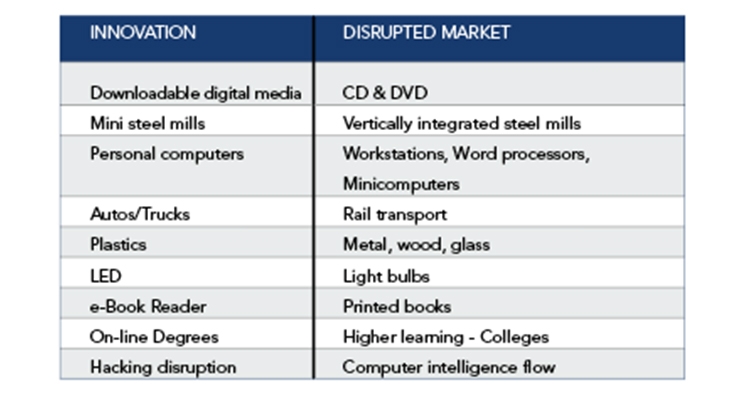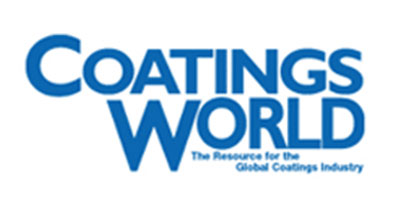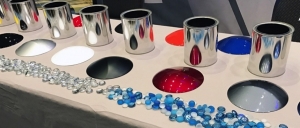08.09.17
A disruptive technology or disruptive innovation is an innovation that helps create a new market and value network, and eventually goes on to disrupt an existing market and value network (over a few years or decades), displacing an earlier technology. The term is used in business and technology literature to describe innovations that improve a product or service in ways that the market does not expect, typically first by designing for a different set of consumers in the new market and later by lowering prices in the existing market.
In contrast to “disruptive” innovation, a “sustaining” innovation does not create new markets or value networks but rather only evolves existing ones with better value, allowing the firms within the market to compete against each other’s sustaining improvements. Sustaining innovations may be either “discontinuous” (i.e. “transformational”) or “continuous” (i.e. “evolutionary”). Transformational innovations are not always disruptive. (1)
In the Wikipedia definitions they further distinguish transformational from disruptive in this example: (2)
Although the automobile was a transformational innovation, it was not a disruptive innovation, because early automobiles were expensive luxury items that did not disrupt the market for horse-drawn vehicles. The market for transportation essentially remained intact until the debut of the lower priced Ford Model T in 1908 by making higher speed, motorized transportation available to the masses.
Eventually, after sustaining innovations within the automotive industry, automobiles displaced horses and their associated businesses. Thus carriage-making, horse trading and saddle repair ceased to be mass, commoditized transportation businesses. In fact, the phrase “buggy whip maker” became a popular figurative description of business models (and their technologies) slain by disruptive technologies.
Another example of a disruptive innovation would be rail transportation. Prior to the railroads, goods were hauled to market via horse drawn wagons and, coincidentally, only to markets relatively near to the sources of the hauled goods. Trains could not only haul goods to much further geographical distances but could haul exponentially greater volumes versus its displaced wagon transportation.
Other examples of disruptive technologies are included in the table above.
Christensen defines a disruptive innovation as a product or service designed for a new set of customers.
“Generally, disruptive innovations were technologically straightforward, consisting of off-the-shelf components put together in a product architecture that was often simpler than prior approaches.
They offered less of what customers in established markets wanted and so could rarely be initially employed there. They offered a different package of attributes valued only in emerging markets remote from, and unimportant to, the mainstream.” (1)
Christensen argues that disruptive innovations can hurt successful, well managed companies that are responsive to their customers and have excellent research and development. These companies tend to ignore the markets most susceptible to disruptive innovations, because the markets have very tight profit margins and are too small to provide a good growth rate to an established (sizable) firm.
Thus disruptive technology provides an example of when the common business-world advice to “focus on the customer” (“stay close to the customer”, “listen to the customer”) can sometimes be strategically counterproductive.(1)
This last Christensen statement unfortunately, is where many small to mid-sized companies are currently struggling. Their historic “focus on the customer” (“stay close to the customer”, “listen to the customer”) emphasis is now placing them in a quandary as they face not only new technology offered by their larger competitor counterparts but they must organize differently as well.
Are these events or product introductions disruptive or transformational?
Environmental Protection Agency creation:
The U.S. Environmental Protection Agency (EPA or sometimes USEPA) is an agency of the federal government of the United States charged with protecting human health and the environment, by writing and enforcing regulations based on laws passed by Congress. The EPA was proposed by President and began operation on December 3, 1970, after Nixon submitted a reorganization plan to Congress and it was ratified by committee hearings in the House and Senate. The agency is led by its Administrator, who is appointed by the president and approved by Congress. The current administrator is Scott Pruitt. The EPA is not a Cabinet department, but the administrator is normally given cabinet rank. The agency has approximately 18,000 full-time employees. (2)
Until the end of November, 1970, the US coatings and paints industry was essentially marketing one technology to most of the end-users in North America. This coating technology was generally described as a low solids, solvent borne paint or coating. The coatings industry environment was slow in growth and marketed as a necessary afterthought in OEM overall design considerations.
Then, in December, 1970 EPA came upon the scene demanding not insignificant but monumental changes in solvent emissions causing our industry to change in an unprecedented manor. Our industry was truly “disrupted” by the intrusion of these new regulations. We had to change not only from a technology offering but we had to change the way we did business as well.
So, we conclude that the creation of EPA was a direct disruptive event to the paints & coatings industry causing downstream transformational wave (not ripple) effects, fragmenting our coatings & paints industry forever. These aftershock waves from the introduction of the EPA regs, were NOT disruptive in and of themselves since by definition, they did not change the appeal to a new customer base and they were “coatings” themselves and not “coating” replacements.
Those of us who were there when EPA came into prominence could certainly argue the term ‘disruptive’ since this event forced us collectively into uncharted technical as well as managerial waters since these new under developed technologies caused major disruption throughout the value chains of market activity. Labs would have to add headcount; spray/emersion equipment would have to change in labs & at the point of application; coatings manufacturing equipment would be expanded; training at all levels of the organization would have to be incorporated; inventories would be fragmented to match the market, etc.
Now, almost 47 years later, we have seen significant consolidation due to many influences from globalization to the Wal-Mart effect of end-user price back-pressures and yes, the disruptive event of EPA creation.
What about the future disruptions in our industry? Can we predict their occurrence and their effect? The answer is, only partially.
The future of our industry’s profitable success lies in two broad business sectors: Management & Technology:
In general, management must move down from its abstract insular environment into more of the realistic portion of the organization and even into the marketplace. Don’t get me wrong, in our consultation we know some of our industry management is doing this now and some degree of being abstract and insulated is good, but extremes in either direction is not going to work in the global business we find ourselves in today. Is the transferring of time, attention and intelligence from the C-Suite to the “street” a disruptive event or a transformative event? Probably the latter but importantly it will change how we do business.
Historically, coatings have served two primary purposes: to protect the underlying surface and to decorate. Functionality has not been a part of our industry’s offerings to any great degree until now. With the advent of biotechnology, we are seeing the emergence of new, “smart” surfaces that are capable of autonomously recognizing the environment and reacting into it. Currently being introduced are functional additives. These naturally occurring additives are designed to provide intelligence to coatings. Some of the intelligence provided is: self-healing, detoxification, non-toxic and non-polluting biocides, self-degreasing surfaces and nerve agent neutralizer.
There are other new functional coating systems being discussed. One such system of high interest is an additive that when incorporated into a marine coating, through its interaction with the naturally occurring metals and minerals in the ocean, sets up a battery effect eliminating the growth of barnacles, thus providing less weight, more “slip” resulting in enormous fuel saving for ocean-going vessels.
Another coating system, utilizing additive made up of a commercially ready carbon-nano-tube technology, can reduce needed film thicknesses/costs in epoxies and urethanes; strengthen the film integrity; making the film 5-7 times more flexible while increasing corrosion protections more than 4 times.
Are these latter innovations disruptive? Very much so! We feel they provide a whole new life for a coating/paint system in their respective applications and markets. They will drive other innovations more quickly. Most importantly, they will drive coatings and paints from an after-thought reactive technology to a front-row seat, proactive in the design of new products to be coated.
1) Christensen, Clayton M. & Overdorf, Michael. (2000).
2) Wikipedia
In contrast to “disruptive” innovation, a “sustaining” innovation does not create new markets or value networks but rather only evolves existing ones with better value, allowing the firms within the market to compete against each other’s sustaining improvements. Sustaining innovations may be either “discontinuous” (i.e. “transformational”) or “continuous” (i.e. “evolutionary”). Transformational innovations are not always disruptive. (1)
In the Wikipedia definitions they further distinguish transformational from disruptive in this example: (2)
Although the automobile was a transformational innovation, it was not a disruptive innovation, because early automobiles were expensive luxury items that did not disrupt the market for horse-drawn vehicles. The market for transportation essentially remained intact until the debut of the lower priced Ford Model T in 1908 by making higher speed, motorized transportation available to the masses.
Eventually, after sustaining innovations within the automotive industry, automobiles displaced horses and their associated businesses. Thus carriage-making, horse trading and saddle repair ceased to be mass, commoditized transportation businesses. In fact, the phrase “buggy whip maker” became a popular figurative description of business models (and their technologies) slain by disruptive technologies.
Another example of a disruptive innovation would be rail transportation. Prior to the railroads, goods were hauled to market via horse drawn wagons and, coincidentally, only to markets relatively near to the sources of the hauled goods. Trains could not only haul goods to much further geographical distances but could haul exponentially greater volumes versus its displaced wagon transportation.
Other examples of disruptive technologies are included in the table above.
Christensen defines a disruptive innovation as a product or service designed for a new set of customers.
“Generally, disruptive innovations were technologically straightforward, consisting of off-the-shelf components put together in a product architecture that was often simpler than prior approaches.
They offered less of what customers in established markets wanted and so could rarely be initially employed there. They offered a different package of attributes valued only in emerging markets remote from, and unimportant to, the mainstream.” (1)
Christensen argues that disruptive innovations can hurt successful, well managed companies that are responsive to their customers and have excellent research and development. These companies tend to ignore the markets most susceptible to disruptive innovations, because the markets have very tight profit margins and are too small to provide a good growth rate to an established (sizable) firm.
Thus disruptive technology provides an example of when the common business-world advice to “focus on the customer” (“stay close to the customer”, “listen to the customer”) can sometimes be strategically counterproductive.(1)
This last Christensen statement unfortunately, is where many small to mid-sized companies are currently struggling. Their historic “focus on the customer” (“stay close to the customer”, “listen to the customer”) emphasis is now placing them in a quandary as they face not only new technology offered by their larger competitor counterparts but they must organize differently as well.
Are these events or product introductions disruptive or transformational?
Environmental Protection Agency creation:
The U.S. Environmental Protection Agency (EPA or sometimes USEPA) is an agency of the federal government of the United States charged with protecting human health and the environment, by writing and enforcing regulations based on laws passed by Congress. The EPA was proposed by President and began operation on December 3, 1970, after Nixon submitted a reorganization plan to Congress and it was ratified by committee hearings in the House and Senate. The agency is led by its Administrator, who is appointed by the president and approved by Congress. The current administrator is Scott Pruitt. The EPA is not a Cabinet department, but the administrator is normally given cabinet rank. The agency has approximately 18,000 full-time employees. (2)
Until the end of November, 1970, the US coatings and paints industry was essentially marketing one technology to most of the end-users in North America. This coating technology was generally described as a low solids, solvent borne paint or coating. The coatings industry environment was slow in growth and marketed as a necessary afterthought in OEM overall design considerations.
Then, in December, 1970 EPA came upon the scene demanding not insignificant but monumental changes in solvent emissions causing our industry to change in an unprecedented manor. Our industry was truly “disrupted” by the intrusion of these new regulations. We had to change not only from a technology offering but we had to change the way we did business as well.
So, we conclude that the creation of EPA was a direct disruptive event to the paints & coatings industry causing downstream transformational wave (not ripple) effects, fragmenting our coatings & paints industry forever. These aftershock waves from the introduction of the EPA regs, were NOT disruptive in and of themselves since by definition, they did not change the appeal to a new customer base and they were “coatings” themselves and not “coating” replacements.
Those of us who were there when EPA came into prominence could certainly argue the term ‘disruptive’ since this event forced us collectively into uncharted technical as well as managerial waters since these new under developed technologies caused major disruption throughout the value chains of market activity. Labs would have to add headcount; spray/emersion equipment would have to change in labs & at the point of application; coatings manufacturing equipment would be expanded; training at all levels of the organization would have to be incorporated; inventories would be fragmented to match the market, etc.
Now, almost 47 years later, we have seen significant consolidation due to many influences from globalization to the Wal-Mart effect of end-user price back-pressures and yes, the disruptive event of EPA creation.
What about the future disruptions in our industry? Can we predict their occurrence and their effect? The answer is, only partially.
The future of our industry’s profitable success lies in two broad business sectors: Management & Technology:
In general, management must move down from its abstract insular environment into more of the realistic portion of the organization and even into the marketplace. Don’t get me wrong, in our consultation we know some of our industry management is doing this now and some degree of being abstract and insulated is good, but extremes in either direction is not going to work in the global business we find ourselves in today. Is the transferring of time, attention and intelligence from the C-Suite to the “street” a disruptive event or a transformative event? Probably the latter but importantly it will change how we do business.
Historically, coatings have served two primary purposes: to protect the underlying surface and to decorate. Functionality has not been a part of our industry’s offerings to any great degree until now. With the advent of biotechnology, we are seeing the emergence of new, “smart” surfaces that are capable of autonomously recognizing the environment and reacting into it. Currently being introduced are functional additives. These naturally occurring additives are designed to provide intelligence to coatings. Some of the intelligence provided is: self-healing, detoxification, non-toxic and non-polluting biocides, self-degreasing surfaces and nerve agent neutralizer.
There are other new functional coating systems being discussed. One such system of high interest is an additive that when incorporated into a marine coating, through its interaction with the naturally occurring metals and minerals in the ocean, sets up a battery effect eliminating the growth of barnacles, thus providing less weight, more “slip” resulting in enormous fuel saving for ocean-going vessels.
Another coating system, utilizing additive made up of a commercially ready carbon-nano-tube technology, can reduce needed film thicknesses/costs in epoxies and urethanes; strengthen the film integrity; making the film 5-7 times more flexible while increasing corrosion protections more than 4 times.
Are these latter innovations disruptive? Very much so! We feel they provide a whole new life for a coating/paint system in their respective applications and markets. They will drive other innovations more quickly. Most importantly, they will drive coatings and paints from an after-thought reactive technology to a front-row seat, proactive in the design of new products to be coated.
1) Christensen, Clayton M. & Overdorf, Michael. (2000).
2) Wikipedia









